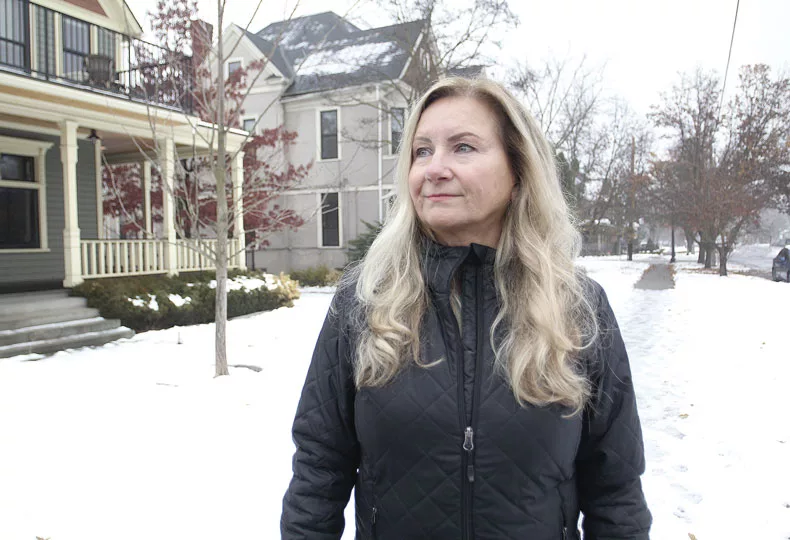
Housing Code Consequences: Zoning meant to encourage middle housing could complicate market
Conflicting laws said to hinder appraisers, borrowers

Residential appraiser Jan Collins says she and others like her won’t be able to appraise houses in Spokane’s city limits as the law currently stands.
| Karina EliasNew city and state laws intended to provide more housing—and more affordable housing—appear to be inadvertently making buying a home more complex, and possibly more expensive.
Essentially, new laws that increase density on what were zoned as single-family lots previously no longer will be eligible for traditional mortgage loans or residential appraisals, but instead will require a commercial or multifamily loan for new purchases and refinancing and commercial appraisals.
Residential real estate appraisers are calling for an amendment to the city’s new housing law taking effect Jan. 1, citing the statute’s impact on appraisers, lenders, buyers, and sellers, says Bob Mossuto, president of the Appraisers’ Coalition of Washington.
At the center of the appraisers’ concerns are federal lending statutes that identify residential property as one to four units, says Mossuto. Five or more units are identified as multifamily property, according to federal statute.
Residential appraisers can appraise properties with up to four units, but five or more units is then considered multifamily by federal law, and requires the appraisal of a commercial appraiser, even if only one unit is located on a parcel, he says.
“Once your new density plan is in effect, the 93 residential real property appraisers will no longer be able to appraise homes once designated as single family in Spokane,” he says. “The time for lending transactions on purchases and refinancing will double, possibly even triple, to six or more months. Lending transactions on one-to four-unit property will essentially halt in Spokane because of the lack of commercial appraisers or commercial appraisers unwilling to appraise what was once the residential appraiser’s job.”
In a letter sent to the Journal, the Appraisers Coalition expresses additional concern for the impact it will have on homeowners and new buyers to obtain affordable financing to purchase or refinance residential real estate within Spokane’s city limits.
“The limitations for funding or real estate transactions are set by federal underwriting guidelines, (Fannie, Freddie, FHA, VA, and USDA),” the coalition states. “These guidelines require that any property with a highest and best use of more than four units be underwritten as commercial property.”
The required qualifications for financing commercial properties are far more stringent, require a commercial appraisal, significantly increasing appraisal fees and turnaround times, which would be detrimental to the underserved members of this community, the coalition adds.
Richard Hagar, a residential appraiser and real estate compliance and regulation expert, says that because the way federal banking laws are set up, HB 1110 would have a major impact on borrowers. There are more loans available for residential mortgages designated for one to four units. However, there are fewer loan options available for units of five or more, which are considered multifamily or commercial real estate, he says.
Part of the reason is because there is a secondary market for purchasing mortgages from banks, he says.
However, if the bank wants to lend on a property with five or more units, the bank does so from money from its own vault, he says.
Spencer Gardner, planning director for the city of Spokane, says he and the City Council have received notice of the appraisers’ concerns. Currently, he is gathering information and connecting with leaders from the banking industry and the Spokane Realtors among others to further understand the issue.
“Ultimately, this is going to need some kind of state action,” says Gardner. “We’re not the only city that’s going to run into this challenge. Other cities are starting to move forward with adoption of the same (House Bill) 1110 requirements.”
House Bill 1110 was adopted in 2022 and requires cities with more than 75,000 residents, or with a continuous urban area with more than 275,000 residents, to allow up to four units per lot anywhere, and up to six units per lot within a quarter mile of a bus stop.
Gardner says Spokane had already been moving toward creating more middle housing—anything that falls into the gap between a single-family house and a large apartment building—since before HB 1110. In June 2022, the City Council passed an immediate change to the city’s code that would allow up to four units on all lots, dubbed Building Opportunity and Choices for All. The ordinance was done quickly as a response to the city’s housing crisis, he says.
In the time between the adoption of Building Opportunity and Choices for All and its expiration, the city has undertaken a broad and in-depth community conversation about housing that included forums, neighborhood outreach and a community survey that received about 3,500 responses, he says.
In June of this year, the city updated its comprehensive plan and turned their attention to the development code, which is a set of rules that govern what people can and can’t build on their property. The last five months have been dedicated to updating the code to allow for middle housing on a permanent basis, not just interim. Last month, the city adopted those changes, and included other changes so that it could be in compliance with HB 1110, he says.
“Our interim ordinance only allowed up to four units, but the state bill is actually telling us we have to allow up to six units,” he says.
Gardner says that from conversations with the community, it was assessed that most residents weren’t concerned with the number of units on a property, but more with the form, scale, and size of buildings. In order to stay compliant with the state statute, Spokane city proposed that it would not limit the number of units on a property and instead allow for a natural limit to occur, based on residents following building guidelines.
Spencer says the city’s outreach process included presentations in forums where he assumed appraisers were present. However, it appears that there was a misconnect, he says.
“We’ve been early adopters, so I think the problem has surfaced here earlier than elsewhere at the end of the day,” he says.
Jan Collins, owner of Spokane Valley-based Collins Appraisal Service LLC, a residential real estate service, says she learned about the changes recently as she was taking on a continuation course to learn how to appraise accessory dwelling units.
As she took the course, she grew concerned that a residential property with four units and an ADU would then be deemed a multifamily property and requiring the appraisal of a commercial appraiser.
“An appraiser of my level cannot appraise that property. It would have to be a general or commercial appraiser, and there are fewer commercial appraisers in Washington,” she says.
ADUs are another form of housing that has been talked about over the past year. House Bill 1337 requires cities across Washington to allow ADUs on every residential property. Currently, Spokane allows one ADU, says Gardner. HB 1337 still needs to be reconciled with the HB1110, he adds.
Collins, who has been an appraiser for 24 years, says there’s a significant difference between a certified residential real estate appraiser and a commercial appraiser. Residential appraisers are simpler and more streamlined, whereas commercial appraisers need to be able to appraise complex structures, such as large department stores and businesses. If she wanted to become a commercial appraiser, she would need to complete 3,000 hours of appraisal experience within a 30-month timeframe, and work under a commercial appraiser to receive 1,500 hours. Commercial appraisers also are required to have a four-year college degree, whereas residential appraisers aren’t required to have a bachelor’s degree in order to get licensed.
“It doesn’t make sense to people that are not in the business, it’s like what’s the big deal?’ she says. “But we’re supposed to look at the best use and if it it’s more than four units…we have to turn that over to a commercial appraiser.”
Hagar says there’s a division between a residential appraiser and a commercial appraiser, because a commercial property is a much more complex property with multiple potential uses and sources of income that can be derived from it.
“They have to be able to appraise the Space Needle, a concrete tilt up building, or a Costco,” he says. “Whereas residential is more streamlined and set up for homeownership to some degree.”
Gardner says that the new housing ordinance is a reinstruction to the way Spokane was built in many ways. Historically, neighborhoods like Browne’s Addition, Cliff Cannon, and the lower South Hill, were built with a different mindset. Families living in generational housing and building duplexes and other dwellings on their property to help cover their mortgage was a way of life. From 1900 to 1910, Spokane added 70,000 new residents, tripling in size.
“That’s how we built ourselves out of that problem was through these housing variety and getting more hands involved,” he says. “Our ancestors built these cities with flexible housing options…over time, we started to make regulations that had the effect of cutting (middle housing) or weakening that part of the market to the point where it was basically a non-entity in Spokane.”
As the city gathers information and prepares to respond to some of the issues raised by the appraisers, he stresses that there will be elements of the statutes that would need to be addressed at the state level and possibly the federal level as well.
“This is a serious matter. We are addressing it as quickly as we can,” he says. “There’s concern about the appraisal industry…I think the greater concern would be just making sure that we’re not negatively impacting people’s ability to get a mortgage.”



_web.webp?t=1764835652)
